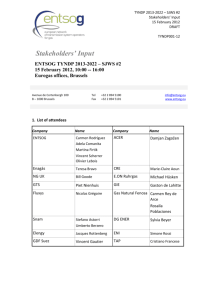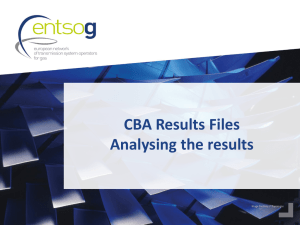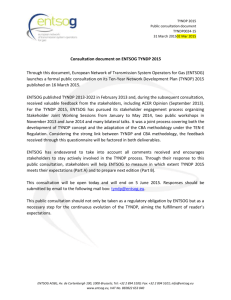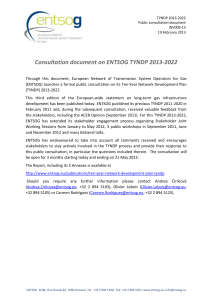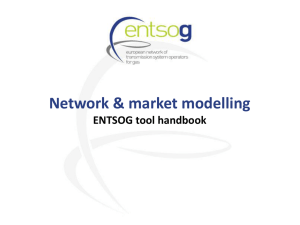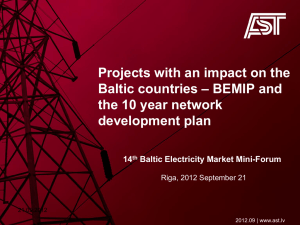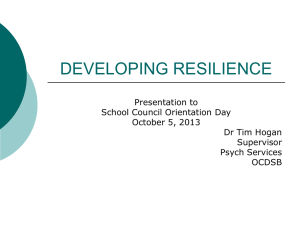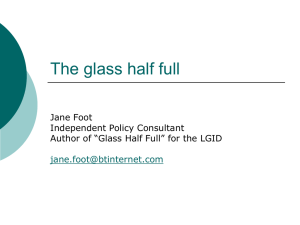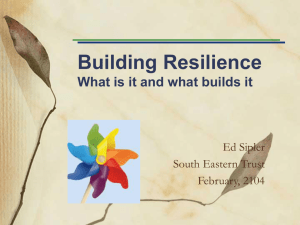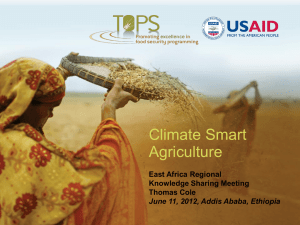TYNDP_120215_SJWS-02_SoS_MI
advertisement
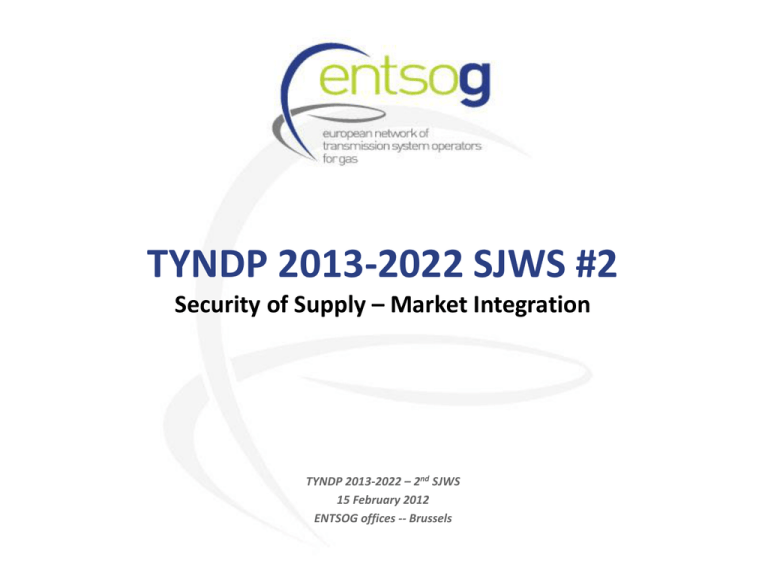
TYNDP 2013-2022 SJWS #2 Security of Supply – Market Integration TYNDP 2013-2022 – 2nd SJWS 15 February 2012 ENTSOG offices -- Brussels Assessment of gas system resilience Role of TYNDP in gas system resilience > Design of the European gas system results from national primary and secondary > > legislation and long term capacity commitments Further need for investment (potential gap) depends on resilience expectation and considered supply/demand scenarios expressed by stakeholders TYNDP aims at providing meaningful input to decision-makers about potential need for additional investment and not at directly planning projects Inputs from SJWSs will be factored in future EIP development > TYNDP and Cost Benefit Analysis have already many converging features: • Scenario definitions • Indicators defining the level of Market Integration and SoS • A network and market model > TYNDP 2013-2022 SJWS can be used as an incubator for the development of a CBA by ENTSOG. But further development will require more visibility and stability of the legislative process 2 Security of Supply resilience assessment in TYNDP 2011-2020 3 Security of Supply resilience assessment European vision > Top-down assessment of the Security of Supply resilience of the European gas > > infrastructure ENTSOG TYNDP considers the impact of major events (climatic, disruption…) from a European perspective on the highly meshed European gas network This top-down approach shows how adjacent systems may influence/support each other TYNDP scope > Current report is based on a Reference Case (high daily demand broadly equivalent > to a 1-in-20 day) and measuring the variation in flow pattern and supply when facing: • a technical, transit or supply disruption • a lower deliverability of storages Considered events have been selected according to their potential impact and occurrence 4 SoS - What is in the TYNDP Main report: gap and remedy identification > Each SoS simulation is the result of following parameter combination: • 2011 / 2015 / 2020 • FID / non-FID • Reference Case / Disruption / UGS low deliverability > A graphical representation of investment gaps is provided when a country > remaining flexibility is below: • 5% under Reference Case • 1% under disruption or UGS low deliverability Congested infrastructures and submitted projects helping to mitigate the gaps are identified within the report Annex E > Nevertheless load factor of each individual project may be estimated using the remaining flexibility provided for projects in Annex E for most scenarios 5 Graphical representation before disruption 6 Graphical representation during disruption TYNDP intends to identify the disrupted areas (blue doted line) defined by complete upstream cross-border congestion (red arrows). Flow pattern within the area would need further investigation taking into account more parameters such as demand-side measures 7 Information provided within the report Numerical information within main body and non-FID project load factor within Annex E Ukrainian disruption (additional investment gaps to the Reference Case) BG <1% Reg. Cong. <1% HR <1% Reg. Cong. <1% FY <1% Reg. Cong. <1% GR <1% BG & TK > GR HU <1% AT & SK > HU RO <1% Reg. Cong. <1% RS <1% Reg. Cong. <1% Global improvement due to AT & SK > HU <1% <1% Total High Daily demand for the region defined by all above countries is covered by 70% with existing infrastructure plus FID and by 75% with addition of non-FID projects. Individual country’s supply demand balance cannot be assessed in this TYNDP due to the current lack of criteria. With non-FID projects (AT to HU capacity increase) remaining flexibility for Austria is inferior to one per cent but still enable to cover the whole demand. 8 SoS - Received feedback Opinion on selected scenarios − − − − − − Interruption of more than one source could be considered Internal technical failure (such Transitgas) should be investigated Reference to possible regional political turmoil may benefit the overall TYNDP Low availability of storage in the end of the winter could be considered More detailed analysis of the selected scenarios would be welcomed Scenarios are appropriate and should be used in next edition in order to assess the improvement − Additional scenarios could derive from REG-SOS Resilience indicator − Remaining flexibility is a meaningful indicator − The arrival of a new supply should reduce the share of the existing one − Embedded diversification of LNG should be considered 9 Market Integration assessment in TYNDP 2011-2020 10 Market integration assessment A concept still to be defined > Market Integration covers many aspects and a clear definition is needed in order to > be able to quantitatively assess European gas infrastructures Assessment on a 10-year range requires a resilient methodology based on robust criteria (direct use of supply and transmission prices is not enough reliable when considering potential variation in level and structure) First European level assessment > ENTSOG considered supply diversification as a strong underlying factor of price > > convergence which is often quoted as a Market Integration indicator (still not a sufficient condition) Market Integration has to be assessed under everyday circumstances This assessment has been carried out under: • A supply perspective: how far a source can send gas • A demand perspective: how many sources a country can have access 11 Market Integration - What is in the TYNDP Main report: spread, diversification & limitation identification > Assessment is carried out on an average day (annual demand and supply divided by > 365 being consistent with April or October days) Each SoS simulation is the result of following parameter combination: • 2011 / 2015 / 2020 • FID / non-FID • Reference Case / Predominant supply (each import source one by one) > A graphical representation of supply spread is provided with 3 ranges of supply shares: • Above 20% • Between 5 and 20% • Below 5% > A view is provided from a country perspective showing the progression in supply diversification of each country 12 Supply source even spread in 2015 (FID) LNG Algeria Norway Russia Libya 13 Source accessibility for end-consumers Number of alternative potential sources # countries having potential access (5% share) to at least 3 sources: 55% 62% 38% 86% 14 Market integration resilience Opinion on selected scenarios − Approach is okay − Even physical spread of supply may not be always appropriate Resilience indicator − − − − − − Supply share should be considered even if less than 5% Percentage could be higher The arrival of a new supply should reduce the share of the existing one 3 sources above 5% is a good and already ambitious target for some markets Embedded diversification of LNG should be considered Modelling should assess if each potential supply can be transported through EU and the potential gap on its path to the end-consumer − TYNDP should identify infrastructures required to have equal capacity level on both side of each IP − Indicator should be updated according Target Model potential output − TYNDP should identify the infrastructure gaps hampering a full use of facilities 15 Thank You for Your Attention ENTSOG -- European Network of Transmission System Operators for Gas Avenue de Cortenbergh 100, B-1000 Brussels EML: T: WWW: info@entsog.eu + 32 2 894 5100 www.entsog.eu 16
